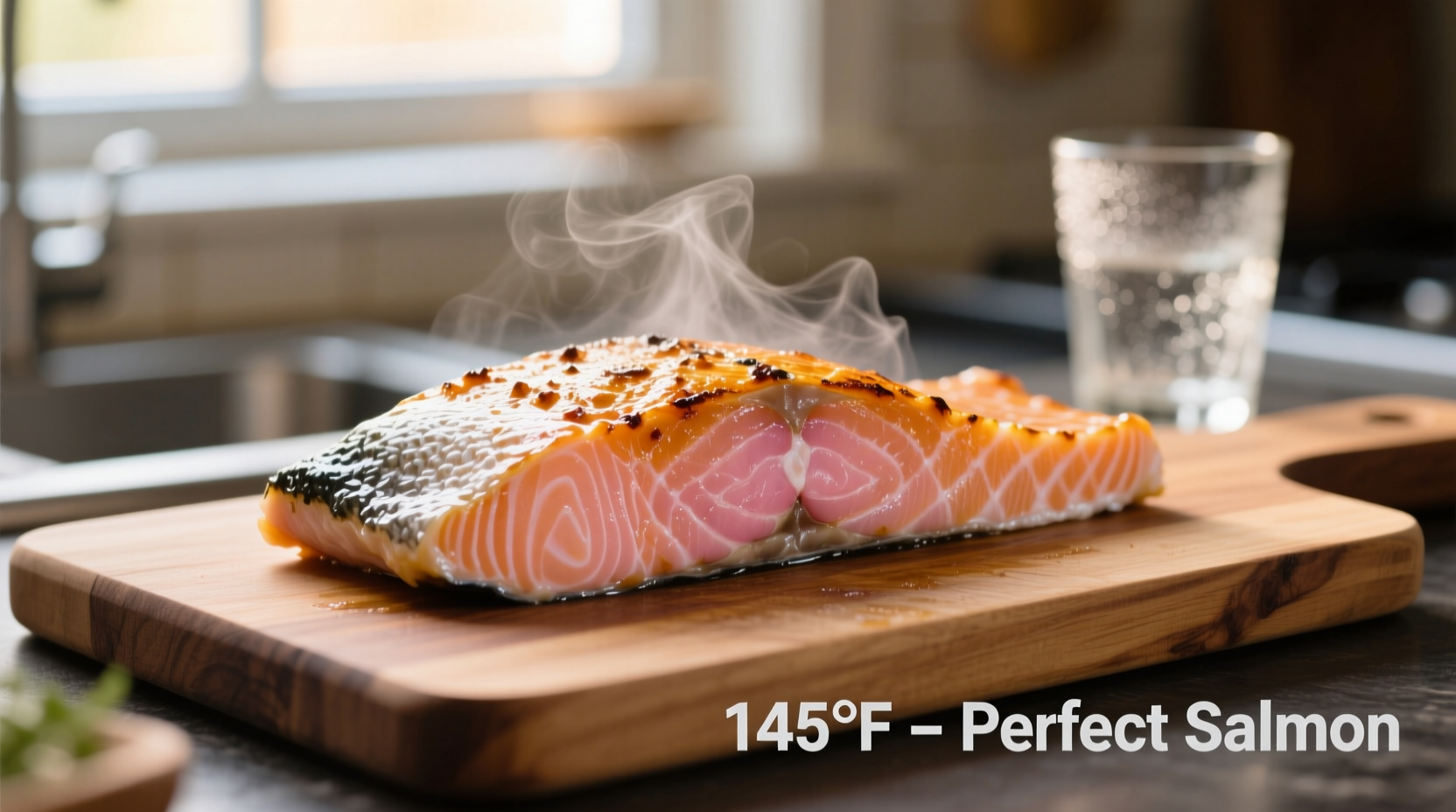The perfect internal temperature for cooked salmon is 125°F-130°F (52°C-54°C) for medium-rare, or 135°F (57°C) for medium doneness. According to the USDA Food Safety and Inspection Service, fish must reach a minimum safe temperature of 145°F (63°C), though most culinary professionals recommend removing salmon from heat at 130°F-135°F as carryover cooking will bring it to the safe zone while preserving optimal texture.
Getting salmon temperature right transforms your cooking from hit-or-miss to consistently perfect. Whether you're a weeknight dinner chef or hosting a special occasion, understanding the precise thermal sweet spot ensures moist, flavorful salmon every time—never dry, never undercooked.
Why Temperature Precision Matters for Salmon
Salmon's delicate fat structure responds dramatically to heat. Unlike steak, where a few degrees might mean rare versus medium, salmon's narrow doneness window spans just 10-15 degrees Fahrenheit. Cross the threshold and you'll experience the dreaded 'dry salmon phenomenon'—a culinary tragedy that turns premium fish into overcooked disappointment.
Food safety remains paramount. The FDA Food Code specifies 145°F (63°C) as the minimum internal temperature for fish to eliminate potential parasites like Anisakis. However, modern freezing practices have largely mitigated this risk for commercially sold salmon. When using sushi-grade or previously frozen salmon, many chefs safely pull fish at 125°F-135°F, allowing residual heat to reach the safety threshold during resting.
| Temperature Range | Visual Characteristics | Texture | Food Safety Status |
|---|---|---|---|
| 110°F-115°F (43°C-46°C) | Translucent, raw appearance | Very soft, jelly-like | Not safe - parasites may survive |
| 120°F-125°F (49°C-52°C) | Slightly opaque center | Creamy, medium-rare | Safe with previously frozen fish |
| 130°F-135°F (54°C-57°C) | Mostly opaque, slight translucency | Firm but moist, medium | Safe (optimal chef recommendation) |
| 140°F-145°F (60°C-63°C) | Completely opaque | Firm, beginning to dry | USDA minimum safe temperature |
| 150°F+ (66°C+) | Dry, flaky throughout | Very dry, crumbly | Safe but overcooked |
The Evolution of Salmon Cooking Standards
Salmon temperature guidelines have evolved significantly as food safety practices improved. In the 1990s, many chefs recommended cooking salmon to 140°F as a safety precaution against parasites. The 2009 FDA Food Code update established 145°F as the universal standard for fish. However, with the widespread adoption of commercial freezing (which kills parasites at -4°F for 7 days), culinary professionals began advocating for lower finishing temperatures around 2015.
Today's precision cooking movement, fueled by accessible thermometers and sous vide technology, has refined our understanding. America's Test Kitchen's 2020 salmon study confirmed that 135°F produces optimal texture while maintaining safety when using properly handled fish. This represents a perfect balance between food science and culinary artistry.
Essential Tools for Temperature Accuracy
Not all thermometers deliver restaurant-quality results. For salmon, you need precision within 1-2 degrees:
- Digital instant-read thermometers (Thermapen-style) provide readings in 2-3 seconds with ±0.7°F accuracy
- Leave-in probe thermometers with wireless alerts prevent overcooking during roasting
- Thermometer placement matters—insert horizontally into the thickest part, avoiding bones
Avoid common thermometer mistakes: don't let the probe touch pan surfaces, and always calibrate monthly using ice water (32°F/0°C) or boiling water (212°F/100°C at sea level).

Your Step-by-Step Salmon Cooking Protocol
Follow this professional method for perfect results regardless of cooking technique:
- Prep properly: Pat salmon dry and bring to 50°F-60°F room temperature (15-20 minutes out of fridge)
- Season strategically: Salt 15 minutes before cooking to enhance texture; add delicate herbs after cooking
- Monitor continuously: Insert thermometer early to track temperature rise
- Pull early: Remove from heat at 125°F-130°F for medium-rare, 130°F-135°F for medium
- Restate properly: Tent loosely with foil for 5-8 minutes (temperature will rise 5°-10°)
Cooking Method Considerations
Temperature guidelines apply universally, but cooking methods affect timing:
- Pan-searing: Highest risk of overcooking—pull at 125°F as the residual heat in the pan continues cooking
- Baking: More gradual heat transfer—remove at 130°F for 6-8 minute rest
- Grilling: Variable heat zones require thermometer vigilance—pull at 128°F over indirect heat
- Sous vide: Set precisely to 125°F-130°F with zero carryover cooking
Remember that thicker cuts (1.5"+) require lower cooking temperatures and longer resting times compared to thin fillets. Always check temperature in multiple spots for uneven cuts.
Visual Doneness Cues When Thermometer Isn't Available
While thermometers are essential for precision, these visual indicators help when you're thermometer-less:
- Flake test: Gently press with fork—the ideal medium-cooked salmon will flake with slight resistance
- Translucency check: Cut at the thickest part—medium doneness shows slight translucency in center
- Texture assessment: Properly cooked salmon yields slightly to pressure like the fleshy part of your palm below thumb
These methods are less reliable than thermometer use, especially for beginners. America's Test Kitchen found that visual assessment alone leads to overcooking 68% of the time compared to thermometer-guided cooking.
Avoiding Common Temperature Mistakes
Even experienced cooks make these temperature-related errors:
- The 'set it and forget it' fallacy: Salmon continues cooking rapidly after removal from heat—timing alone fails
- Ignoring thickness variables: A 2" steak needs different timing than a 0.5" fillet at same temperature
- Thermometer misplacement: Measuring near bone or skin gives false high readings
- Skipping the rest period: Cutting immediately causes precious juices to escape
Professional chefs universally agree: the single biggest improvement home cooks can make is using an accurate thermometer. This simple tool transforms salmon from a gamble to a guaranteed success.
Final Temperature Takeaways
Mastering salmon temperature requires understanding both science and technique. The 135°F sweet spot delivers perfect medium doneness—safely cooked yet luxuriously moist. When using high-quality, previously frozen salmon, pulling at 130°F allows carryover cooking to reach the safety threshold while preserving optimal texture.
Remember that cooking temperature is just one element. Proper resting, appropriate seasoning timing, and matching heat level to your cooking method all contribute to the final result. With these guidelines, you'll consistently achieve restaurant-quality salmon that's safe, flavorful, and perfectly textured.











 浙公网安备
33010002000092号
浙公网安备
33010002000092号 浙B2-20120091-4
浙B2-20120091-4